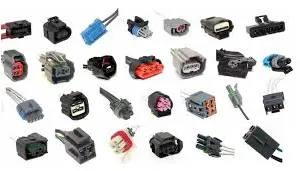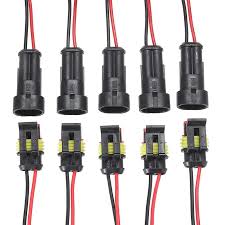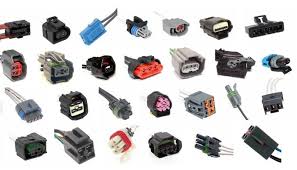The Evolution and Impact of Electrical Connectors in Modern Technology
Electrical connectors are essential components that facilitate secure and reliable electrical connections between devices. They come in various types, each designed for specific applications and environments. Connectors play a crucial role in industries ranging from automotive and aerospace to telecommunications and consumer electronics, ensuring seamless communication and power transmission. Their components include contacts, insulators, housing, locking mechanisms, and termination methods. Understanding and selecting the right type of connector is crucial for efficient and safe electrical systems.
Types of Electrical Connectors

Electrical connectors play a pivotal role in modern technology, enabling the seamless transmission of electrical signals and power between various electronic devices and systems. From household appliances to industrial machinery, electrical connectors are ubiquitous in our daily lives.
Definition and Function of Electrical Connectors
Electrical connectors are fundamental components in electrical and electronic systems, designed to establish a secure and reliable connection between two or more conductors. Their primary function is to facilitate the flow of electrical current, allowing for the transmission of signals or power from one point to another.
Components of Electrical Connectors:
- Contacts: These are the conductive elements within the connector responsible for carrying electrical current. Contacts are typically made of materials like copper, gold, or silver due to their high conductivity.
- Insulators: Surrounding the contacts, insulators provide electrical insulation and mechanical support. They are commonly constructed from materials like plastic, ceramic, or glass.
- Housing: The housing encloses the contacts and insulators, offering protection from environmental factors such as moisture, dust, and mechanical stress. It is usually made of robust materials like metal or high-quality plastics.
- Locking Mechanism: Many connectors feature a locking mechanism to secure the connection and prevent accidental disconnection. This can be in the form of screws, latches, or bayonet couplings.
- Termination: Termination refers to the method used to attach the connector to a cable or circuit board. It can include soldering, crimping, or insulation displacement.
Functionality of Electrical Connectors:
- Establishing a Connection: The primary purpose of an electrical connector is to join conductors, creating a pathway for electrical current to flow from one point to another. This connection can be temporary or permanent, depending on the application.
- Ensuring Signal Integrity: Connectors play a crucial role in maintaining the integrity of electrical signals. High-quality connectors minimize signal loss and distortion, ensuring that the transmitted signal accurately represents the original input.
- Preventing Environmental Impact: Connectors are designed to protect the connection from environmental factors that could potentially degrade performance. This includes shielding against moisture, dust, vibration, and temperature variations.
- Enabling Disconnection: Connectors also allow for easy disconnection when needed. This is essential for maintenance, repairs, or when components need to be replaced.
- Facilitating Compatibility: Connectors come in various types and configurations, designed to meet specific industry standards and requirements. This ensures that devices and systems from different manufacturers can interface and work together seamlessly.
Components of Electrical Connectors
Electrical connectors are essential components in electrical and electronic systems, facilitating the secure and reliable transmission of electrical signals and power between various devices. They are composed of several key elements, each playing a crucial role in their functionality.
1. Contacts
Contacts are the conductive elements within the connector responsible for carrying electrical current. They are typically made of materials known for their high electrical conductivity, such as copper, gold, or silver. Contacts can take various forms, including pins, sockets, blades, or solder cups, depending on the specific design of the connector.
2. Insulators
Insulators provide electrical insulation and mechanical support within the connector. They surround the contacts, preventing unintended electrical contact between them and ensuring that the current flows only through the designated conductive paths. Insulators are commonly constructed from materials like plastic, ceramic, glass, or composite materials with specific dielectric properties.
3. Housing
The housing encloses the contacts and insulators, offering protection from environmental factors that could potentially impact the connection. This includes safeguarding against moisture, dust, chemicals, and mechanical stress. Housings are typically made from durable materials like metal alloys, high-quality plastics, or other specialized materials designed to withstand specific environmental conditions.
4. Locking Mechanism
Many connectors feature a locking mechanism to secure the connection and prevent accidental disconnection. This additional feature is particularly important in applications where vibrations, movement, or external forces may potentially disrupt the connection. Locking mechanisms can take various forms, including screws, latches, bayonet couplings, and quick-release mechanisms.
5. Termination
Termination refers to the method used to attach the connector to a cable, wire, or circuit board. It is a critical aspect of ensuring a secure and reliable electrical connection. Different termination methods include soldering, crimping, insulation displacement, and wire-wrap techniques. The choice of termination method depends on factors such as the application, conductor type, and environmental conditions.
6. Seals and Gaskets
In connectors designed for outdoor or harsh environments, seals and gaskets provide an additional layer of protection against moisture, dust, and other contaminants. These components are strategically placed within the connector to create a barrier, preventing the ingress of harmful elements that could compromise the integrity of the connection.
7. Strain Relief
Strain relief features are incorporated into some connectors to alleviate mechanical stress on the cable or wire where it enters the connector. They help prevent the conductor from being damaged or disconnected due to bending, pulling, or twisting forces.

Types of Electrical Connectors
Electrical connectors come in a diverse range of designs, each tailored for specific applications. These connectors are essential components that facilitate the seamless transmission of electrical signals and power between various electronic devices and systems.
1. Circular Connectors
Circular connectors, as the name suggests, feature a cylindrical shape. They are known for their robustness and reliability, making them suitable for applications where durability and resistance to environmental factors are crucial. Circular connectors find extensive use in industries such as aerospace, military, and industrial automation. Their design allows for secure connections even in challenging conditions.
2. Rectangular Connectors
Rectangular connectors have a box-like, rectangular shape. They are commonly employed in electronic devices, computers, and automotive applications. These connectors offer a higher contact density compared to circular connectors, making them suitable for applications requiring numerous connections within limited space. Rectangular connectors are versatile and widely used across various industries.
3. Coaxial Connectors
Coaxial connectors are designed for transmitting high-frequency signals with minimal interference. They consist of an inner conductor, an insulating layer, and an outer conductor (shield). This configuration helps to maintain signal integrity and prevent external interference. Coaxial connectors are widely used in telecommunications, radio equipment, and television systems.
4. RF Connectors
Radio Frequency (RF) connectors are specialized connectors designed for high-frequency applications. They come in various types, each tailored for specific frequency ranges and power levels. Common types of RF connectors include SMA (SubMiniature version A), BNC (Bayonet Neill-Concelman), and N-type connectors. RF connectors are crucial in applications like wireless communication systems, antennas, and radar equipment.
5. Terminal Blocks
Terminal blocks serve as a convenient means of connecting wires or cables to a fixed electrical component. They are commonly used in electrical panels, control systems, and industrial automation applications. Terminal blocks provide a secure and organized method for making electrical connections. They come in various configurations, including barrier, DIN rail-mounted, and screw-type terminal blocks.
6. USB Connectors
Universal Serial Bus (USB) connectors are widely used for connecting various peripherals, such as keyboards, mice, printers, and external storage devices, to computers and electronic devices. They come in different versions, including USB-A, USB-B, and USB-C, each designed for specific applications and offering varying data transfer speeds and power capabilities.
7. Audio and Video Connectors
Audio and video connectors are specialized connectors designed for transmitting audio and video signals. Common types include RCA connectors (used for analog audio and video signals), HDMI connectors (used for high-definition digital audio and video signals), and VGA connectors (used for analog video signals). These connectors are essential in home entertainment systems, audiovisual equipment, and multimedia applications.
Applications of Electrical Connectors
Electrical connectors are versatile components that play a pivotal role in a wide range of industries and applications. Their ability to establish secure and reliable electrical connections makes them indispensable in modern technology.
1. Automotive Industry
The automotive industry heavily relies on electrical connectors for various applications. Connectors are used in wiring harnesses to connect sensors, actuators, lights, and control units. They play a crucial role in ensuring efficient communication between different components of a vehicle, including the engine control unit, transmission, airbag systems, and entertainment systems. With the rise of electric and hybrid vehicles, high-voltage connectors have become essential for power distribution.
2. Aerospace and Aviation
In the aerospace and aviation industry, connectors are subjected to extreme conditions, including high altitudes, rapid temperature fluctuations, and intense vibrations. Circular connectors, known for their robustness, are commonly employed in aircraft systems. They facilitate secure connections for critical components such as avionics, navigation systems, communication systems, and lighting.
3. Telecommunications
Connectors are integral to the functioning of telecommunications networks. Coaxial connectors and RF connectors are essential for transmitting high-frequency signals with minimal loss. They are used in antennas, base stations, signal amplifiers, and other telecommunications equipment. These connectors ensure the smooth transmission of signals across vast distances, supporting our interconnected world.
4. Industrial Automation
In industrial settings, connectors are used extensively to connect sensors, actuators, controllers, and other automation components. They play a vital role in establishing communication within complex control systems. Connectors enable seamless coordination between different elements of automated machinery, enhancing efficiency and productivity in manufacturing and assembly processes.
5. Medical Devices
Medical equipment relies heavily on electrical connectors for various applications. Connectors are used in patient monitoring systems, diagnostic imaging equipment (such as MRI and CT scanners), surgical instruments, and other medical devices. These connectors must meet stringent safety and reliability standards to ensure the accuracy and effectiveness of medical procedures.
6. Consumer Electronics
In the realm of consumer electronics, connectors are ubiquitous. They are found in devices such as smartphones, laptops, televisions, cameras, and gaming consoles. USB connectors, HDMI connectors, and audio jacks are just a few examples of the connectors that enable these devices to communicate with each other and with external peripherals.
7. Power Distribution and Energy Systems
Electrical connectors are crucial in power distribution networks, facilitating the transmission of electricity from power plants to homes and businesses. High-voltage connectors are used in substations and power transmission lines, while lower voltage connectors are employed in household wiring and electrical panels. They ensure safe and reliable distribution of electrical power.
8. Renewable Energy
In the field of renewable energy, connectors play a vital role in solar and wind energy systems. They are used to connect photovoltaic panels, inverters, and batteries in solar power installations. Additionally, connectors are utilized in wind turbines to interconnect generator components and transmit power to the grid.

What type of electrical connectors are best
The choice of the best type of electrical connector depends on the specific application, environmental conditions, electrical requirements, and other factors. There is no one-size-fits-all answer, as different connectors excel in different scenarios.
- Application and Industry: Consider the industry and application where the connector will be used. For example, connectors used in the automotive industry may have different requirements compared to those used in aerospace or telecommunications.
- Environmental Conditions: Assess the environmental conditions the connector will be exposed to. Factors such as temperature, moisture, dust, chemicals, and vibration levels can impact the choice of connector. For harsh environments, connectors with robust sealing and shielding capabilities are essential.
- Voltage and Current Ratings: Ensure that the connector is rated to handle the specific voltage and current levels of the application. Using connectors with appropriate voltage and current ratings is crucial to prevent overheating, arcing, and potential damage.
- Signal Integrity and Frequency Requirements: For applications where signal integrity is critical, such as in telecommunications or high-frequency systems, connectors with low signal loss, impedance matching, and shielding capabilities are essential.
- Mechanical Durability: Consider the level of mechanical stress and vibration the connector will experience. Connectors in applications like automotive or aerospace should be robust and capable of withstanding high levels of mechanical stress.
- Mating Cycles: Evaluate how frequently the connector will be mated and unmated. Some connectors are designed for high mating cycle applications, while others are more suitable for static connections.
- Size and Form Factor: The physical size and form factor of the connector are crucial, especially in applications with space constraints. Rectangular connectors, for instance, offer higher contact density, while circular connectors are known for their durability.
- Ease of Installation and Maintenance: Consider factors like ease of termination, accessibility, and compatibility with installation tools. Connectors that are easy to install and maintain can save time and effort during assembly and maintenance tasks.
- Industry Standards and Compliance: Ensure that the chosen connector complies with relevant industry standards and certifications. This ensures compatibility and interoperability with other components in the system.
- Cost and Budget Constraints: While it's important to prioritize performance and reliability, cost considerations are also crucial. Balancing performance with budget constraints is essential in any engineering project.
how to install electrical connector
Installing an electrical connector involves ensuring a secure and reliable connection between conductors or devices. The specific steps may vary depending on the type of connector and the application.
Materials Needed:
- Electrical connector
- Wire strippers or crimping tool (if required)
- Screwdriver or other appropriate tools (if required)
- Insulation tape or heat shrink tubing (if required)
- Safety equipment (e.g., gloves, safety glasses)
Step-by-Step Guide:
- Prepare the Wires:
- Ensure that the wires you intend to connect are clean and free from any dirt, grease, or corrosion.
- If the wires have insulation, use wire strippers to carefully remove a small section of insulation from each wire end. This will expose the bare conductor for connection.
- Select the Connector:
- Choose the appropriate type and size of connector for your application. Consider factors such as wire gauge, current ratings, and environmental conditions.
- Insert Wires into the Connector:
- If using a connector with screw terminals, open the connector and insert the bare ends of the wires into the appropriate terminals. Ensure that each wire is securely seated.
- Crimp the Connector (if applicable):
- For connectors that require crimping, use a crimping tool to compress the connector onto the wires. This creates a secure mechanical and electrical connection.
- Screw or Secure the Connector:
- If the connector has screws, tighten them to securely hold the wires in place. Be sure not to overtighten, as this could damage the connector or wires.
- Insulate the Connection (if required):
- If needed, use insulation tape or heat shrink tubing to cover the connection. This provides additional protection against moisture, dust, and other environmental factors.
- Test the Connection:
- Before finalizing the installation, conduct a continuity or resistance test to ensure that the connection is secure and there are no short circuits.
- Secure the Connector (if applicable):
- Some connectors have locking mechanisms or features to prevent accidental disconnection. Ensure that the connector is securely locked in place.
- Perform a Visual Inspection:
- Visually inspect the connection to ensure there are no loose wires, exposed conductors, or signs of damage.
- Document and Label (if necessary):
- If working in a complex system with multiple connectors, consider labeling or documenting the connections for future reference.
- Complete Additional Connections (if required):
- Repeat the above steps for any additional connections that need to be made.
- Perform Functionality Tests (if applicable):
- Depending on the application, conduct functional tests to ensure that the connected devices or circuits are operating as expected.
Safety Tips:
- Always ensure that power is disconnected before working with electrical connectors to prevent electric shock or short circuits.
- Use appropriate safety equipment, such as gloves and safety glasses, when handling electrical components.
- Follow manufacturer's instructions and specifications for the specific connector being used.
As we stand on the precipice of a new technological era, it's essential to acknowledge the role of electrical connectors as the unsung heroes of our interconnected world. Their evolution from humble beginnings to intricate, specialized designs has propelled industries forward and improved the way we live, work, and communicate. The impact of connectors is felt in every aspect of our lives, and as technology continues to advance, so too will the innovation and importance of these critical components. Embracing the significance of connectors is key to unlocking the full potential of our interconnected future.



